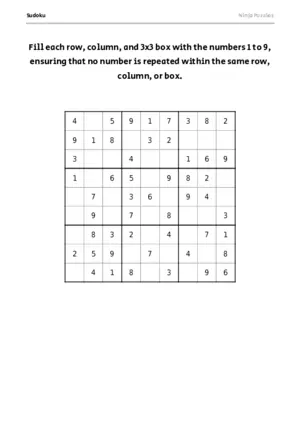Sudoku: Y-Wing Strategy and Techniques
The Y-Wing Sudoku strategy is an advanced solving technique in Sudoku puzzles that involves three cells and three numbers forming a specific pattern. It can lead to deductions that help solve other squares in the puzzle. Here’s a step-by-step guide on how to use the Y-Wing strategy:
- Analyze the Puzzle: Examine the grid and identify a set of three cells that have candidate numbers.
- Identify the Y-Wing Pattern: Look for a pattern where two of the cells are linked by sharing the same candidate number, while the third cell is connected to both but has a different candidate number. The three cells should form a “Y” shape.
- Examine Implications: Focus on the candidate number shared by the two linked cells and consider its implications within the puzzle. Look at how its presence or absence in other cells affects their candidates.
- Make Deductions: Depending on whether or not the candidate number appears in the connected cell, you can make deductions about other squares in the puzzle. This is done by eliminating certain candidate numbers based on constraints resulting from this relationship.
- Update Puzzle: After making deductions based on the Y-Wing Sudoku pattern, reassess the puzzle and repeat the process if necessary, looking for additional Y-Wing opportunities.
Mastering this strategy requires practice and familiarity with identifying Sudoku Y-Wing patterns and their implications. As you gain experience, you’ll become more proficient at using this technique to make deductions that bring you closer to solving even challenging Sudoku puzzles.
Sudoku Solver
If you get really stuck then we have an online Sudoku Solver, and a Sudoku Mini Solver to help you solve the most challenging Sudoku puzzles.
Advanced Sudoku Strategies
- Singleton Technique: This strategy involves identifying squares that have only one possible candidate number based on the numbers already present in the row, column, and box.
- Naked Pairs and Triples: When two or three squares in a unit (row, column, or box) have the same two or three candidate numbers, those numbers can be eliminated as possibilities from other squares in the unit.
- Hidden Pairs and Triples: This strategy focuses on identifying two or three candidate numbers that only appear in the same two or three squares within a unit. These numbers can then be eliminated as possibilities from other squares in the unit.
- Sudoku X-Wing: Sudoku X-Wing involves finding two rows or two columns where the same number can only occur in the same two positions. By eliminating that number as a possibility in the corresponding rows or columns, you can make further deductions.
- Swordfish: Similar to Sudoku X-Wing, Swordfish strategy expands the concept to three rows or three columns. It involves finding three rows or three columns where the same number can only occur in the same three positions, allowing for further eliminations.
- Sudoku Y-Wing: Sudoku Y-Wing is an advanced strategy that involves three cells and three numbers. By utilizing a specific pattern of candidate numbers, you can make deductions that lead to solving other squares.
- Sudoku XYZ-Wing: XYZ-Wing involves three cells and three numbers, with each number belonging to a different candidate list. It allows for deductions by creating chains of eliminations based on the relationships between the three numbers.
- Coloring: This strategy involves assigning colors (usually two) to candidates and using the relationships between these colors to make deductions.
- Backtracking: Backtracking is a brute-force technique that involves making educated guesses and trying different possibilities until a contradiction is reached or the puzzle is solved.








